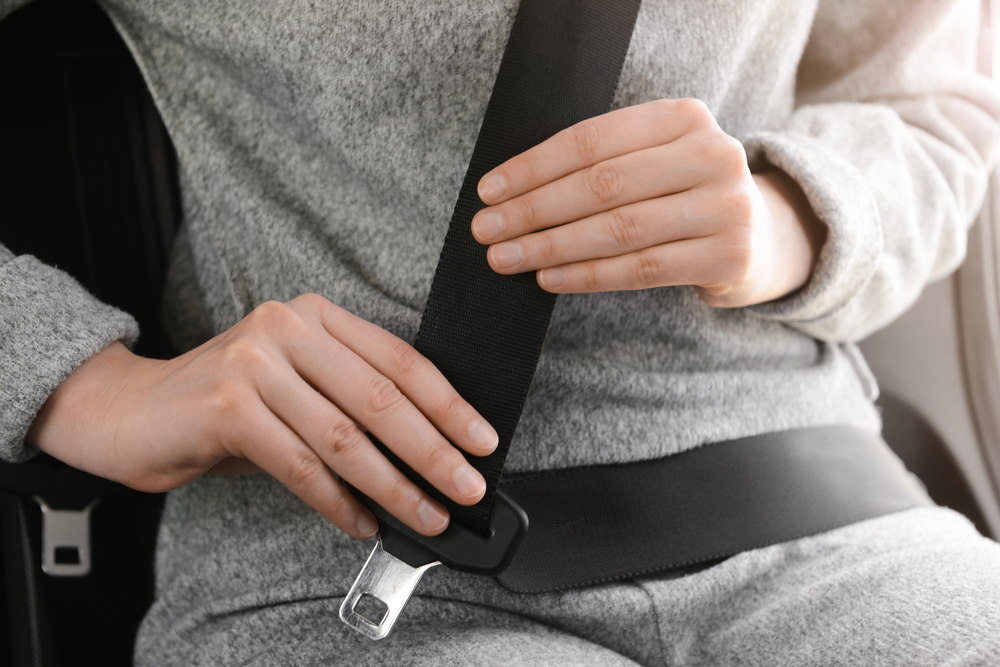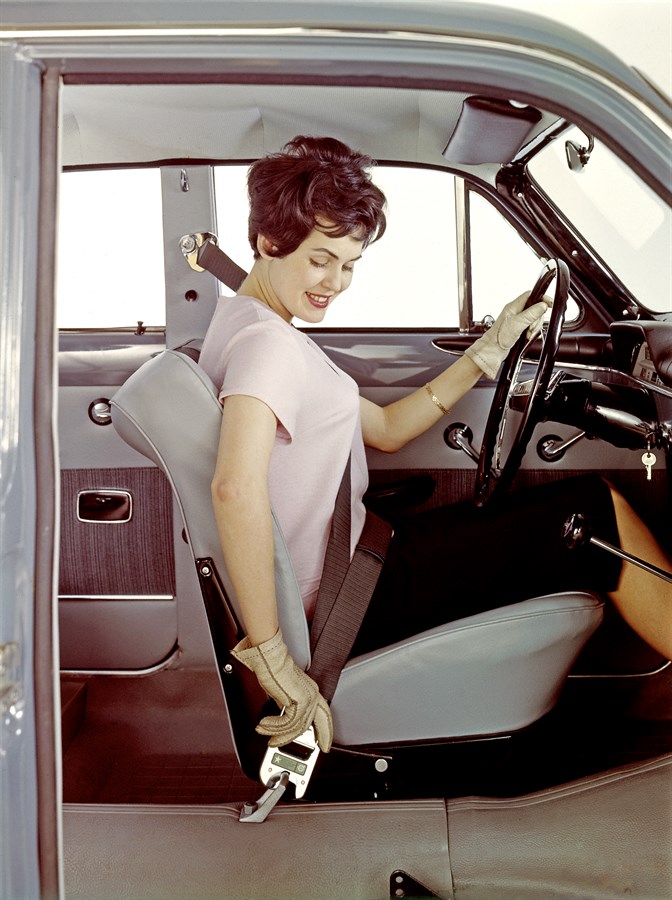TL;DR: Timeline of the Evolution of Seat Belts:
- Late 1880 – The first seat belt was invented by Sir George Cayley (Spoiler: It was designed for a glider plane).
- 1885 – Edward J. Claghor patented the first automotive seat belt designed to keep tourists safe in New York taxis.
- 1930s – Few physicians started testing their version of lap belts to minimise injury during accidents.
- 1946 – Dr C. Hunter Shelden, a neurologist by trade, designed retractable seat belts.
- 1949 – Nash was the first company to sell cars with seat belts as a paid accessory.
- 1951 – Two Americans, Roger Griswold and Hugh De Haven, patented a shoulder and lap restraining seat belt, which paved the way for modern three-point seat belts.
- 1959 – Nils Bohlin, a Volvo engineer, developed the three-point seat belt – the modern seat belt design seen today. Volvo PV544 became the first car to come with 3-point seat belts as standard.
- 1960s – Widespread adoption of seat belts by automakers started.

Time to buckle up!
Early cars had seat belts as an optional extra, but now they are essential safety devices for modern cars and one of the most significant innovations in automotive history. In fact, seat belts have saved countless lives and prevented numerous serious injuries.
Today, we’ll delve into the seat belt’s history, its evolution, who invented it and when, and how it became mandatory in vehicles. We will also discuss the differences between three-point seat belts and two-point seat belts. So, buckle up and join us on this journey through the history of seat belts!
The not-so-automotive start
You might be surprised that the first search belts were not developed for cars but rather for a glider. English aeronautical engineer Sir George Cayley invented the first known seat belt for his monoplane glider in the late 1800s, which set the foundation for the development of the automobile seat belt. It was a single-strap lap seat belt designed to keep the hips in place.
In 1885, Edward J. Claghorn was granted the patent (#312,085) for an automotive seat belt designed to keep tourists safe in New York taxis.
The early 2-point seatbelt (also known as lap belt)
The two-point seat belt was the first type of seat belt to be introduced in automobiles around the 1930s. This seat belt was made up of two straps, one over the lap, and one over the shoulder, connected by a single buckle.
The origin of the 2-point seat belt is unclear, but some say back then, few physicians started testing their version of lap belts in their cars to reduce the risk of injury during accidents and urged automakers to provide seat belts. Several inventors and engineers are likely to have contributed to the development of the two-point seat belt, but no single person can be credited with its creation.
This early version of the seat belt was functional for a basic degree of protection but did not off all-around protection. For example, when a two-point seat belt was used in a vehicle, occupants were protected from being thrown from the vehicle during a crash. However, the two-point seat belt lacked chest protection and had the tendency to slide up during a crash, causing abdominal injuries. It was also difficult for people of different sizes to use the two-point seat belt effectively since it was not adjustable.
Commercial implementation
In 1949, American car company Nash was the first to sell cars with the option of a 2-point seat belt. In 1958, French automaker Saab was the first company to introduce seat belts as standard across all its model.

Retractable Seat Belt
In 1946, Dr C. Hunter Shelden, a neurologist by trade, noticed many head injuries among car crash victims and began researching why this was the case. His findings led to the introduction of retractable belts. He also proposed the idea of airbags, door locks, seating positions and roll bars for driver and passenger safety.
A two-point seat belt was a major step forward in automotive safety, but its design made it clear that there was much room for improvement.
Did Volvo invent the 3-point seat belt?
In 1951, two Americans, Roger Griswold and Hugh De Haven, patented a 3-point shoulder and lap restraining, which was later improved to what we know as the three-point seat belt today. The major difference with the implementation was that the buckle remained in the middle.
The three-point seat belt, or the modern seat belt as we know it, was invented in 1959 by Nils Bohlin, a Swedish engineer working for Volvo. Nils improved the design allowing one to pull the seat belt across the chest and waist with just one hand. It consists of two straps that cross over the chest and lap and are fastened with one buckle. Since its introduction, this design has become the global standard for vehicle protection and is the seat belt design we often see today.
A three-point seat belt is better than a two-point seat belt because of the security it offers over both the waist and the chest. With a strap that runs along the front of the torso and one that runs across the hips, passengers are held securely in their seats during a crash. The design also prevents the seat belt from riding up during the accident, preventing abdominal injuries, which were common in two-point design.
The First Car Models to Introduce Seatbelts
Since Nils Bohlin, a Volvo employee, was the inventor of the modern-day seatbelt, it will come as no surprise that the Volvo cars were the first to implement them into their vehicles. In 1959, the Volvo PV544 was the first car to come with three-point seat belt as standard fitment. Other automakers also saw merits in the three-point seat belt and its improved level of protection compared to the two-point seat belt. Manufacturers began offering three-point seat belts as an option or standard feature in the following years.
Worldwide, three-point seat belts became increasingly common in vehicles by the late 1960s thanks to widespread adoption by car manufacturers. Three-point seat belts helped lay the foundation for improved automotive safety and have saved countless lives. Today, the three-point seat belt is considered a standard feature in virtually all passenger vehicles and remains one of the most important innovations in automotive history.

The History of Seatbelt Laws
In many countries, seat belts have been mandatory since the 1960s, when car manufacturers widely adopted three-point seat belts. To increase seat belt usage and reduce the number of injuries and fatalities resulting from motor vehicle accidents, seat belt laws have evolved and become more stringent over time.
In 1970, Victoria, Australia passed the first seat belt law, requiring front seat occupants to wear them. Similar laws followed in other countries, including the United Kingdom, which passed a seat belt law in 1983.
Following the progression of other countries, the United States came on board with seatbelt legislation.
New York instituted the first seat belt law in 1984, which required drivers and front-seat passengers to wear seat belts. As a result, other states passed their seat belt laws within a few years. By 1986, Congress passed a law that provided incentives to states that passed seat belt laws, and by 1994, all states had adopted some form of seat belt legislation.
Among some of the last states to pass laws regarding seat belt legislation were Texas and Florida. In Texas, drivers saw the first seat belt law passed in 1985, which required drivers and front seat passengers to wear seat belts. This law was later expanded in 2009 to require all passengers, including those in the back seat, to wear seat belts while in a moving vehicle.
Florida was a bit behind Texas in passing the new law, where the first seat belt law wasn’t passed until 1986, and it only required drivers and front seat passengers to wear seat belts. This law was later expanded in 2000 (9 years before Texas) to require all passengers to wear seat belts, regardless of their seating position.
Seatbelt Laws are Seen Worldwide
Many countries now require seat belt use in all seats, not just the front seats, with seat belt laws becoming even more strict in recent years. Furthermore, some countries have adopted “primary enforcement” laws, which allow law enforcement officers to stop and cite drivers even if there are no other violations.
There has been a gradual increase in recognition of the importance of seat belts and their role in reducing fatalities and injuries in motor vehicle crashes throughout history. There are seat belt laws in many countries today, and they play an instrumental role in increasing the use of seat belts and preventing passenger-related road accidents.
Wrapping Up
There has been no greater innovation in automotive history than seat belts. Through their invention, countless lives have been saved and countless injuries have been prevented. The widespread adoption of seat belts, along with seat belt laws, has led to increased seat belt usage. This has played a significant role in reducing the number of fatalities and injuries in motor vehicle crashes.
Seat belts work by distributing the force of a crash across the strongest parts of the body, reducing the risk of injury. They also help to keep occupants inside the vehicle during a crash, reducing the risk of being thrown from the vehicle or colliding with other objects.
The simple truth is that seatbelts save lives. It is essential that you wear your seat belt, regardless of whether you are a driver or a passenger. So, always remember to buckle up every time you get into a vehicle. It could make the difference between life and death.
Sources & references:
- https://www.media.volvocars.com/us/en-us/media/pressreleases/91446/photos
- https://www.history.com/this-day-in-history/three-point-seatbelt-inventor-nils-bohlin-born
- https://en.wikipedia.org/wiki/Seat_belt_laws_in_the_United_States
